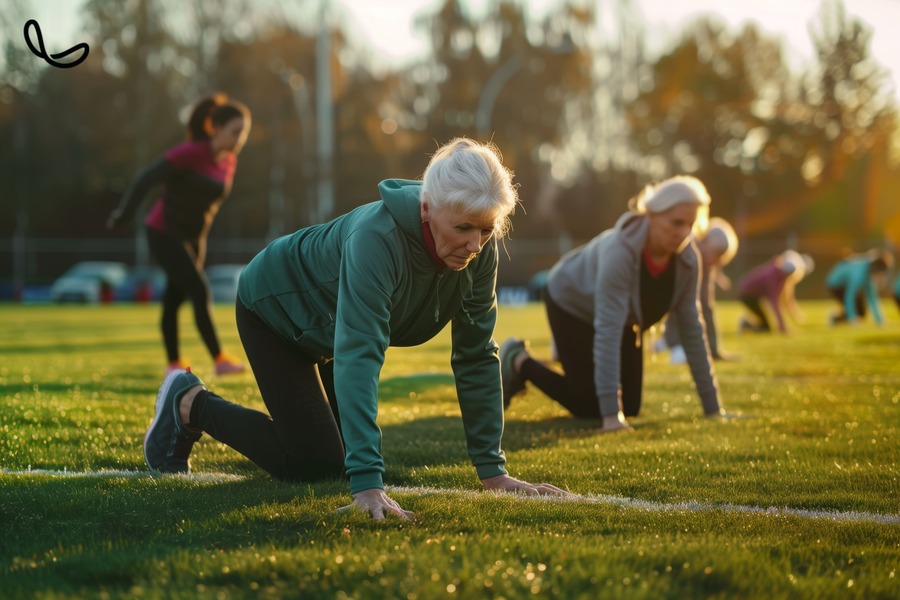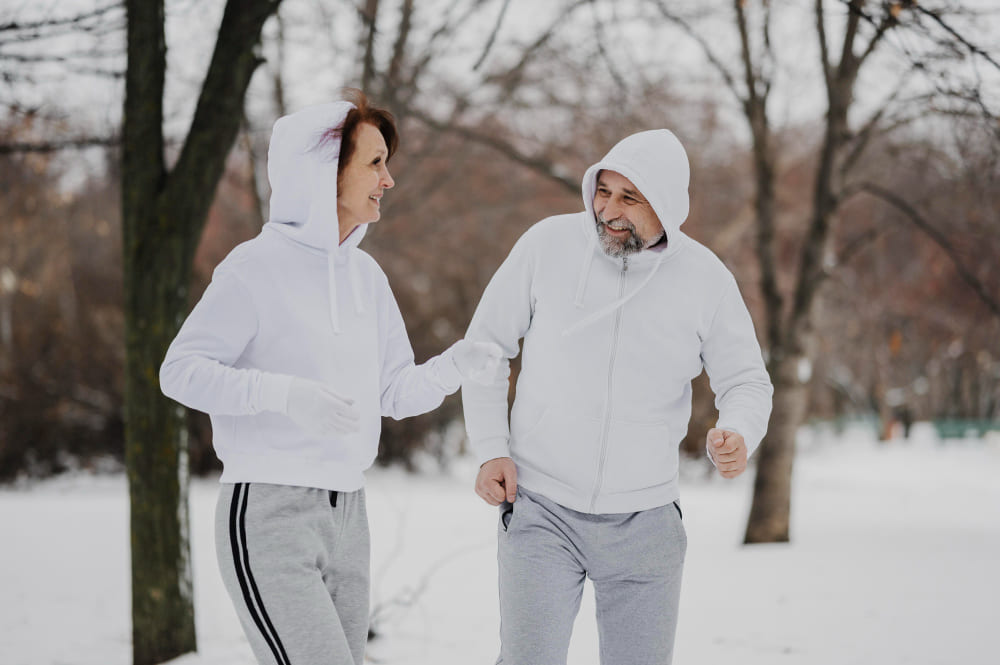As we age, it’s natural for the body to go through a series of physical changes. Muscle loss, decreased bone density, and joint stiffness are among the most common signs. However, there is good news: these effects of aging can be counteracted with a regular exercise routine.
Exercise after the age of 50 not only helps maintain physical fitness but also plays a crucial role in mental and emotional well-being. Staying active releases endorphins, which improve mood and reduce stress levels. Additionally, exercise can strengthen cognitive function, helping to prevent issues such as memory loss and dementia.
Several studies have shown that individuals over the age of 50 who exercise regularly not only live longer but also enjoy a better quality of life. Research from Harvard University reveals that those who engage in moderate physical activity have a 31% lower risk of mortality compared to sedentary individuals. Similarly, the Mayo Clinic has demonstrated that exercise is a key factor in preventing diseases like diabetes, hypertension, and certain types of cancer.
Exercise is not just a tool to stay active but a path to a healthier and more satisfying life, both physically and mentally.
How to Lead a Healthy Life After 50
From the age of 50 onwards, leading a healthy life goes beyond staying physically active—it’s about balancing all aspects of health: exercise, nutrition, rest, and emotional well-being. Adopting a holistic approach is key to enjoying a fulfilling life and prolonging longevity. Our Sensalus App helps you maintain this balance.
1. Holistic Health: Exercise, Nutrition, and Longevity
Exercise is undoubtedly a fundamental pillar, but it is not the only one. To maintain optimal health, it is essential to complement physical activity with a balanced diet rich in nutrients that support overall well-being. A study published in The American Journal of Clinical Nutrition found that people over 50 who combine regular exercise with a proper diet have a better quality of life and live longer than those who focus solely on one of these aspects.
What does this mean in practice? It means opting for protein-rich foods, calcium, vitamin D, and B12 to strengthen bones and muscles. Including fresh fruits and vegetables, healthy fats like avocados and olive oil, and complex carbohydrates to maintain energy. In this way, the body receives the fuel necessary to continue functioning at its best, even after 50.
2. Exercise and Sleep Improvement
Adequate rest is another key component of leading a healthy life. With age, problems like insomnia or interrupted sleep become more common, which can negatively impact overall health. Fortunately, exercise not only improves physical fitness but also has a positive impact on sleep quality.
A study published in Sleep Medicine Reviews revealed that individuals over 50 who engage in regular exercise experience a significant improvement in sleep quality, reducing the incidence of insomnia. Sleeping well helps the body recover from physical exertion, improves mental health, and contributes to maintaining a strong immune system.
If you’ve ever had trouble sleeping, incorporating exercise into your routine may be the solution. Activities like walking, yoga, or swimming are not only beneficial for your body but also help you achieve a deeper and more restorative sleep.
What Happens If I Exercise at Age 50?
Staying active after age 50 brings a series of invaluable benefits to physical, mental, and emotional health. Beyond improving physical fitness, regular exercise has a profound impact on overall well-being. Let’s explore some of the most notable effects of exercise at this stage of life.
1. Mental Health Benefits of Exercise
Exercise is a powerful antidote to depression and stress. A study published in The Lancet Psychiatry revealed that people over 50 who exercise regularly report 43% fewer days of poor mental health compared to those who lead a sedentary life. Physical activity, even in moderate forms such as walking or yoga, releases endorphins—known as the “happiness hormones”—which improve mood and reduce stress.
For people over 50, incorporating exercise into their daily routine can be a key tool for maintaining a healthy and balanced mind. The benefits go beyond stress reduction; exercise also improves self-esteem and promotes a general sense of well-being.
2. Cognitive Health and Aging
As we age, it’s natural to worry about cognitive decline. However, regular exercise can make a significant difference in this area. A study from Columbia University showed that exercise significantly improves cognitive function and reduces the risk of developing dementia and other age-related disorders.
Staying active promotes blood circulation to the brain, which stimulates the growth of new neural connections. This not only helps maintain memory and cognitive skills but can also delay the onset of neurodegenerative diseases. Thus, a consistent exercise routine is an investment not only in your body but also in your long-term mental health.
3. Reducing the Risk of Chronic Diseases
One of the biggest benefits of exercising after 50 is its ability to prevent chronic diseases. A study published in the Journal of Aging and Physical Activity concluded that people over 50 who exercise regularly have a significantly lower risk of developing type 2 diabetes, hypertension, and arthritis.
Exercise helps maintain a healthy weight, improves insulin sensitivity, and reduces blood pressure, lowering the risk of cardiovascular and metabolic diseases. Additionally, by strengthening muscles and joints, it can also relieve arthritis symptoms and improve overall quality of life.
What is the Best Physical Activity After Age 50?
Staying active after age 50 is essential for improving health and quality of life. There are various exercise options, but some are more effective at this stage of life. Let’s explore the best options and how to adapt them to your particular situation.
Aerobic Exercise
Cardiovascular exercise is crucial for heart and lung health. Activities like walking, cycling, or aerobic water exercises are perfect for improving cardiovascular endurance without putting too much strain on the joints. These exercises are also excellent for boosting energy and improving general well-being.
For those over 50, it is recommended to do at least 150 minutes of moderate aerobic exercise per week, which equals about 30 minutes a day, 5 days a week. If you prefer something lighter, walking or cycling are effective and accessible options to improve cardiovascular health without risk of injury.
Strength Training
If you only have time for one type of exercise, the recommendation is to prioritize strength training. As we age, it’s common to experience muscle loss, known as sarcopenia, which can affect mobility and increase the risk of falls. Strength training with light weights, resistance bands, or bodyweight exercises is key to preventing these problems.
Strength training is also vital for maintaining bone density, which helps prevent fractures and diseases such as osteoporosis. It is recommended to do strength exercises at least twice a week, focusing on the main muscle groups. In addition to improving muscle mass, these exercises also benefit balance and flexibility.
If you have limited time, prioritize strength training. It will not only keep your muscles and bones strong but also improve your posture and overall mobility.
Flexibility and Balance
As the years pass, flexibility and balance become increasingly important to prevent falls and maintain independence in daily activities. Practices like yoga, pilates, and Tai Chi are highly recommended to improve flexibility, mobility, and balance.
Tai Chi, in particular, is an excellent option for older adults as it focuses on gentle, controlled movements that strengthen balance and coordination. Additionally, yoga and pilates help improve posture and strengthen the core, which also contributes to better body control.
HIIT or Functional Training
For those already accustomed to exercise and seeking a greater challenge, HIIT (High-Intensity Interval Training) can be an ideal option. This type of training combines short bursts of intense exercise with rest periods, improving both strength and cardiovascular endurance in shorter sessions. However, it’s important to consult a professional before starting this type of training, especially if you have any pre-existing conditions.
On the other hand, functional training is also an excellent option to improve functional strength and endurance, with movements that simulate daily activities and help improve overall mobility.
Conclusion
At 50 and beyond, staying active is not just a good idea—it’s almost a necessity. Yes, we may not have the energy we had in our 20s (or even in our 30s), but exercise helps us feel stronger, more agile, and, best of all, healthier. Strength training is the key to keeping muscles and bones in shape, and if you can add some cardio or improve your flexibility, even better.
It’s not about running marathons or lifting huge weights (unless you feel like it); it’s about finding what works for you and doing it regularly. At the end of the day, a little effort here and there can make a big difference.
After all, the fitter we are, the more we’ll enjoy those extra years we’ve earned, right?
This article is based on:
- Harvard University study on longevity and exercise: “Harvard study longevity exercise older adults”: Shows how regular physical activity reduces the risk of mortality and improves quality of life in older adults.
- Mayo Clinic study on aging and physical health: “Mayo Clinic aging exercise health benefits”: Highlights the relationship between exercise and the prevention of chronic diseases like type 2 diabetes, hypertension, and osteoporosis.
- The Lancet Psychiatry study on the mental health benefits of exercise: “The Lancet Psychiatry exercise mental health”: Demonstrates the benefits of exercise for mental health, significantly reducing the risk of depression and improving emotional well-being.
- Columbia University study on exercise and cognitive function: “Columbia University exercise cognitive function older adults”: Shows how regular exercise improves cognitive function and reduces the risk of developing dementia in older adults.
- Journal of Aging and Physical Activity study on reducing the risk of chronic diseases: “Journal of Aging and Physical Activity exercise chronic diseases older adults.”
- The American Journal of Clinical Nutrition study on combining exercise and a balanced diet: “American Journal of Clinical Nutrition exercise diet quality of life longevity”: Concludes that people over 50 who exercise regularly have a much lower risk of developing chronic diseases.
- Sleep Medicine Reviews study on exercise and sleep improvement: “Sleep Medicine Reviews exercise older adults sleep quality”: Shows how regular exercise improves sleep quality in older adults, helping to reduce problems like insomnia.








